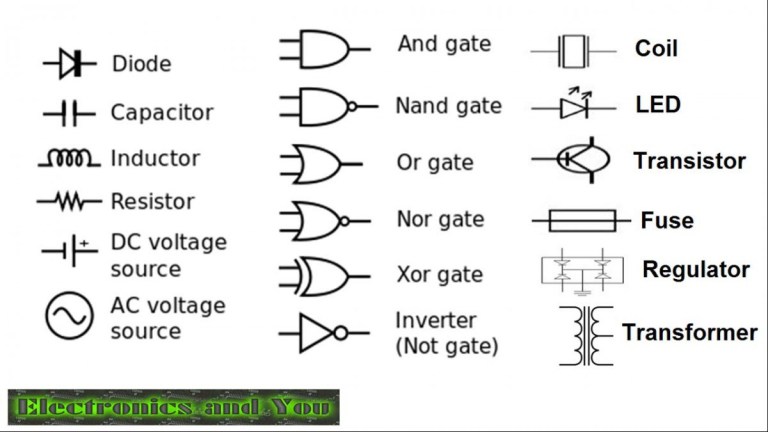Active and Passive Electronic Components
All about Active and Passive Electronic Components. Examples and Difference between Active and Passive Electronic Components
Active and Passive Electronic Components are two classes of electronic components. Both these classes of electronic components are different from each other. This article explains all about active and passive electronic components with examples and the difference between the two.
Table of Contents:
What are Active Electronic Components?
Active electronic components are those that can control the flow of electricity. Different Types of Printed Circuit Boards have at least one active component. Some examples of active electronic components are transistor, vacuum tubes, silicon-controlled rectifiers (SCRs).
Complete List of Active Electronic Components
Here is complete list of most common and widely used Active Electronic Components. I have not mentioned the Obsolete Components.
| Semiconductors | Transistors |
|
|
| Integrated Circuits (ICs) | Other Components |
|
|
What are Passive Electronic Components?
Passive electronic components are those that don’t have the ability to control electric current by means of another electrical signal. Examples of passive electronic components are capacitors, resistors, inductors, transformers, and some diodes. These can be either Thru-Hole of SMD Components.
Complete List of Passive Electronic Components
Here is complete list of most common and widely used Passive Electronic Components. I have not mentioned the Obsolete Components.
| Basic Components | Electromechanical Components |
|
|
What is a Resistor?
A Resistor is an electrical device that resists the flow of electrical current. It is a passive device used to control, or impede the flow of, electric current in an electric circuit by providing resistance, thereby developing a drop in voltage across the device.
What is a Capacitor?
A capacitor is a passive electrical component that can store energy in the electric field between a pair of conductors called “plates”. The process of storing energy in the capacitor is known as “charging“. The ability of a capacitor to store charge is measured by its capacitance.
Capacitors are used in electronic circuits as energy storage devices. They are also be used to differentiate between high-frequency and low-frequency signals. A wide variety of capacitors are available, including electrolytic capacitors, basic parallel-plate capacitors, and mechanical variable capacitors.
What is a Diode?
A diode is a one-way valve for electricity. Diodes allow flow of electricity in one direction. Most diodes have a painted line on one end showing the direction or flow. The negative side is normally white.
What is an Integrated Circuit (IC)?
Integrated Circuits (ICs) are package of several complex circuits. ICs are available in a wide variety of packages and sizes. Their applications are as varied as their packages.
What are Transistors?
A transistor is a semiconductor device. It is the fundamental building block of the circuitry in mobile phones, computers, and several other electronic devices. A transistor has very fast response and is used in a number of functions including voltage regulation, amplification, switching, signal modulation, and oscillators.
Transistors may be packaged individually or they can be a part of an integrated circuit. Some of the ICs have billion of transistors in a very small area.
Circuit Symbols of Active and Passive Electronic Components
Role of Active and Passive Electronic Components in a Circuit
Electronic components, both active and passive, are lifeline of any Printed Circuit Board assembly. They both play vital roles in the functioning of any electronic device.
Electronic Components are intended to be connected together, usually by soldering to a printed circuit board (PCB), to create an electronic circuit with a particular function.
Video: Active Vs Passive Electronic Components – Difference, Example, Function
FAQs: Passive Vs Active Components in Electronics
What is the difference between active and passive electronic components? Give Examples.
Active components actively control the flow of electrical current, often amplifying signals. Passive components don't control current and generally affect voltage, current, or frequency characteristics.
Example - An example of an active component is a transistor, which amplifies signals. Example of a passive component is a resistor, which resists the flow of current.
What are the functions of active and passive components?
Active components amplify weak signals, switch currents, and provide voltage gain. They are crucial for signal processing and amplification in various devices.
Passive components store energy, filter signals, and control the flow of current. They are used for voltage division, frequency filtering, and timing circuits.
Where are active and passive components used?
Active components are found in devices like amplifiers, oscillators, and microcontrollers. They are vital in audio systems, radio communications, and digital logic circuits.
Passive components are used in power supplies, signal conditioning, filters, and impedance matching. They play roles in audio equipment, communication systems, and lighting circuits.
How do active and passive components work together?
Active and Passive Electronic Components often collaborate in electronic circuits. Active components amplify and process signals, while passive components regulate voltage, shape waveforms, and provide stability.
Example - In an audio amplifier circuit, active transistors amplify weak audio signals. Passive components like capacitors and resistors help in coupling signals, filtering noise, and setting gain levels.
Related Posts:
- Circuit Symbols of Electronic Components
- Electronic Components Manufacturers, Suppliers and Distributors
- Electronic Components, Parts and Their Function
- Transistor: Building Blocks of Modern Electronics
- Top Electronic Companies in the World
- Printed Circuit Board: Design, Diagram and Assembly
- Where To Buy Electronic Components in India
- All about Semiconductor
- Uses of Silicon in Electronics
- Electronic Components Name Abbreviations and Symbols
- Basic Electronic Components – Types, Functions, Symbols
- Top 10 Electronic Components Manufacturers in the World













Please include the fabrication. Of semiconductor and oxidation process
Nice Post!!
Thanks for sharing informative blog about electronic component.
You said passive elements can not control the flow of electricity but a resistance controls the flow of electricity if we connect it in the circuit. So it should come in active element category. I think your definition is totally wrong
Thank you so much for sharing this fantastic blog.., You have shared nice information about electronic components.
Good explanation
Thank you for sharing your blog with us and thank you for being helpful for people,
your blog is Very impressive and motivational! The blog is highly informative and has answered all my questions.
I liked it but I need the textbook
Fantastic!
Hi, Thank you for sharing. I have found an interesting Arduino projectsfor you.
very detailed information about parts, now i understand. thank you
Thank you for great information.